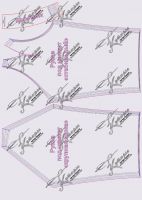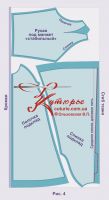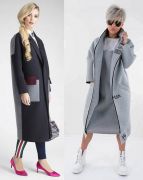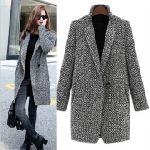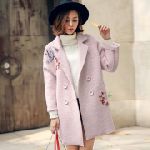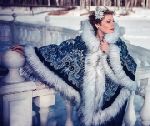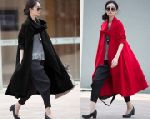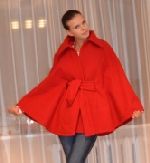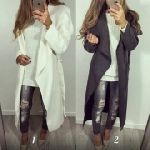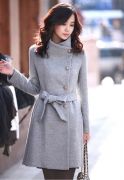Size charts What is the height of the pattern Payment methods Ask a question Reviews
Electronic pattern of a raglan flared coat with a stand for printing on a home printer or plotter in full size for sizes from 42 to 62. It is printed on sheets of paper from A4 to A0.
 Download free instructions on how to sew a flared coat according to a pattern...
Download free instructions on how to sew a flared coat according to a pattern...
Description of the pattern and style, consumption and choice of fabric for sewing a coat
Description:
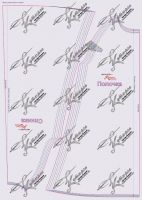 Sizes: 42-52 and 52-62 (the buyer receives all sizes of the selected gradation)
Sizes: 42-52 and 52-62 (the buyer receives all sizes of the selected gradation)
File format for download in order:
PDF in full size and without seam allowances.
After paying for the order, you will receive links to download two files coat patterns for each of your chosen gradations of sizes:
- PDF file A4, adapted for printing patterns on sheets of A4 paper in any program on any device, including mobile phones.
- Multi-format PDF file for printing on sheets of any size from A0 to A4 on a printer or plotter using Adobe Reader.
Sewing difficulty level: professional - the product is difficult and not recommended for sewing by beginners.
Coat pattern set
- Back
- Shelves
- Raglan sleeve "stable" - a pattern for sewing from stable fabrics
- Raglan sleeve "large knit" - a pattern for knitwear large knit.
- Stand-up collar for sewing in stable fabric.
Patterns for knitted cuffs and collar are not included, as they are rectangles. About the sizes of rectangular details, see below in the description of cutting and sewing.
Style and fabric consumption
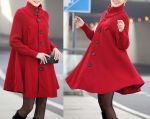 This style of coat is suitable for all types of figures of any height.
This style of coat is suitable for all types of figures of any height.
The consumption of fabric for sewing a model from one cut of overcoat fabric (all parts are from overcoat fabric) with a width of 140 - 150 cm will be from 250 to 310 cm. An accurate calculation should be performed with ready-made patterns after specifying the length of the sleeve and product.
The consumption of fabric for sewing a combined coat is as follows:
coat fabric consumption - 180 - 210 cm with a width of 140 - 150 cm;
consumption of coarse knitwear with long sleeves - 100 - 110 cm with a width of 140 - 150;
consumption of coarse knitwear for sleeves with cuffs - 90 - 100 cm with a width of 140 - 150 cm;
 the consumption of coarse knitwear with a width of 170 - 180 cm will be one sleeve length plus 5 cm for a lining or other unforeseen operations, that is, up to 75 - 80 cm.
the consumption of coarse knitwear with a width of 170 - 180 cm will be one sleeve length plus 5 cm for a lining or other unforeseen operations, that is, up to 75 - 80 cm.
If only the cuffs and collar are knitted, and the sleeve is made of overcoat fabric, the consumption of the “cuff”-pipe (tie) will be up to 50-55 cm, depending on the width of the cuff and the height of the collar. This is with a typical pipe width of 35-40 cm.
What to sew a raglan flared coat with a stand
Any coat fabric can be used for tailoring, but if you are going to combine them with knitwear, especially if you use knitted sleeves, the coat fabric should be quite light.
For example, thin-clothed drape (semi-drape), cashmere, or tweed. Pile fabrics are also suitable, as well as boucle and loden.
For sewing beginners who want to experiment with sewing, you can use fleece or footer.
For knitted details, you can use both self-knitted knitwear and purchased. If you only need cuffs and a collar, the usual “tie”, aka “cuff”, will do.
The lining fabric is preferably sliding - it is better to take a satin.
Instructions for buying and self-printing
How to print a life size pattern on A4 sheets
How to choose a pattern size without taking measurements and using tables
 Buy and download this coat pattern...
Buy and download this coat pattern...
Features of cutting and sewing a combined raglan coat
Before cutting, it is extremely important to determine the desired length of the sleeve as accurately as possible. To facilitate the task of pattern sleeves are given full length.
First, we determine the full length of the sleeve, measuring the sleeve according to the figure from the side point of the neck through the shoulder point and through the bent elbow to the wrist.
Perhaps, 3-5 cm should be added to the length of the sleeve with cuffs for a lap. The amount of overlap depends on the properties of the fabric or knitwear.
Then we determine the length of the cuff and cut off the “excess” from the sleeve pattern (figure 2 c, d).
In the same figure, we will consider how to cut out a one-piece selection (figure 2 a). In fact, a one-piece bead is a strip of fabric between the edge line of the bead and the hem. The line width is usually
Double the distance between the half-skid and the edge of the bead + 1 or 2 cm
Such a simple calculation makes it possible for buttons and loops to freely “place on the selection”.
Also note that the top cut of the one-piece selection is directed upwards to prevent it from falling under the collar. This line is arbitrary, after ironing, the pick can be set up.
 We will add seam allowances already in the process of cutting, but now they can be considered - we add 1 - 1,2 cm everywhere, except for the cuts of the neck. Bottom - 3 cm.
We will add seam allowances already in the process of cutting, but now they can be considered - we add 1 - 1,2 cm everywhere, except for the cuts of the neck. Bottom - 3 cm.
Particularly noteworthy are the features of cutting the lining of the shelf using the template of the shelf (figure 2 b). This pattern needs to be “cut” (in fact, just bent) along the line, the distance between the desired line and the edge of the bead is
Pick-up width minus 2 cm
A similar story is with the lining for the sleeves, with or without cuffs - the lining should be 2 - 3 cm longer than the sleeve.
Now open it yourselfpicture 3). We fold the fabric in half face to face, combine the edges and place them parallel to the edge of the cutting table.
The layout is not difficult, the direction of the share thread is marked on the drawings. The shelf - the share coincides with the half-skid and the edge of the side, the back - with the middle line of the back, but the middle seam of the back should be "oblique".
For those who like to sew flared coats without a middle back seam, I have bad news - the sides will stretch out, and the middle of the back will “jump”, the coat will look terrible. So the middle seam is necessary and it should not fall on the equity thread.
Cutting the collar, especially if you cut it out of coat fabric, it is advisable to postpone until the second fitting, that is, the lower collar should be cut after the final processing of the shoulder sections, including the WTO.
In this case, you already clearly know the length of the neck of a particular product and cut out the collar along it.
So, first we cut out the lower collar - none of the cuts should fall on the lobar or transverse thread. Let me remind you that this applies only to the collar made of overcoat fabric.
On the lower collar with seam allowances, we cut out the upper collar - circled and cut it out, thus increasing the upper collar exactly by the size of its fit.
The share for the upper collar coincides with the middle line.
We duplicate the selection and collars.
The cutting of the lining is shown in 4 drawing. In order not to be mistaken, you can cut it out according to the details of the cut - they already have allowances. It is better to cut out the back lining by attaching it to the fold. On the middle seam, you can make a tuck slot in the area of the shoulder blades, which will increase the wear resistance of the lining.
Now the fun part - cutting the knitted sleeves and cuffs.
It is better to cut coarse knitwear at home by spreading it out in one layer. Shared direction - along the details (picture 5).
The height of the knitted collar in the cut is
Double ready collar height + 2 or 2,5 cm
 The height of the knitted cuff in the cutting is
The height of the knitted cuff in the cutting is
Double height finished cuff + 2 or 2,5 cm
The width of the collar detail depends on two indicators:
- Knitwear properties
- Neck cut length.
Check the width of the collar empirically, but it will most likely fluctuate between 40 and 50 cm.
The width of the cuff also depends on the properties of the knitwear, but it is easy to check on the wrist - it should be close to the girth of the wrist.
Should I add allowances for the processing of the collar and cuffs or lay allowances for the width of the parts? It is more convenient to lay in width, since it is very difficult to mark up on knitwear.
As for sewing, raglan, contrary to the erroneous opinion of beginners learning to cut and sew, does not simplify, but complicates the tailoring of the product.
Knitwear, with its convenience, is too demanding for processing. When using knitted sleeves, you must consider a special "dubbing" for these sleeves in order to avoid unwanted deformation of the product. Tight, but thin knitwear of the same color as the “top” is best.
The “upper” knitted sleeves must be quilted by hand with a dense knitted lining with oblique stitches up to 3 cm long. The distance between the stitch lines is up to 3 cm.
It is also desirable to hem wide elastic bands into the cuffs. The elastic bands are sewn in large zigzags across the entire width of the elastic band to the wrong side of the inside of the cuff.
The collar should also be reinforced with thick knitwear or rubber threads, threading them into the collar.
Otherwise, this coat is sewn in the same way as other flared raglan coats with a one-piece hem.
Download this pattern pdf:
Pattern coat raglan flared with a stand
$2.50 (100 hryvnia)
Bank cards of the Russian Federation are not accepted for payment!
Size charts What is the height of the pattern Payment methods Ask a question Reviews
Vera Olkhovskaya in social networks:

-
Any pattern for free for a review of a previously made order
More...
Lifetime promotion for buyers of patterns!

Leave a review about my store of patterns for an order that you made before, and you will receive any paid pattern of your choice Free!

